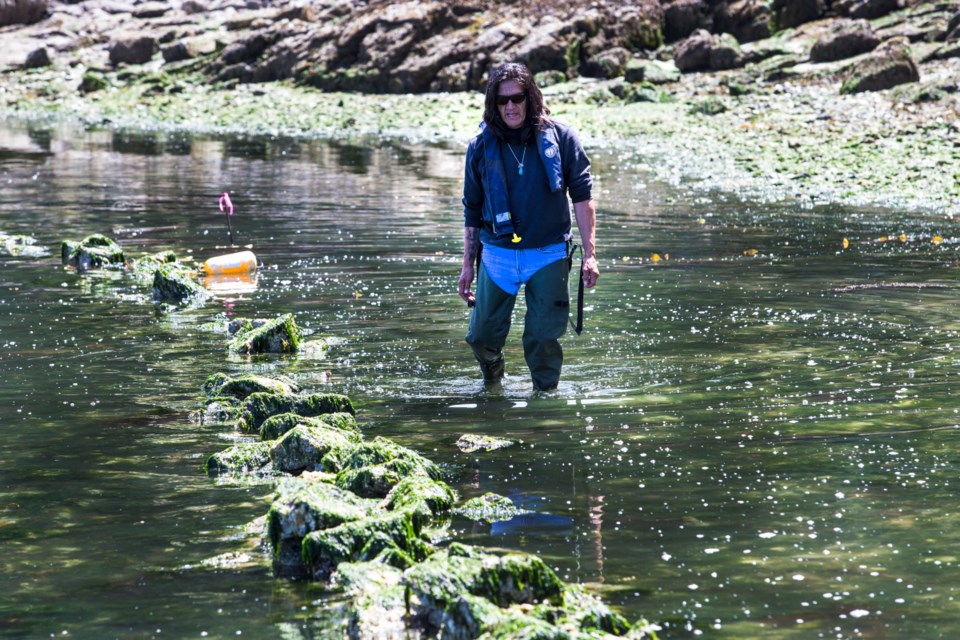When the tide is low enough along a small beach on Russell Island, two arches of large rocks poke through the water and veils of seaweed.
Over centuries, Indigenous people have built the walls that form clam gardens in the area near the mouth of Fulford Harbour on Saltspring Island — and likely thousands of others along the coast.
The rocks at the top of this clam garden were added in the past year or so as part of a restoration project, but the submerged foundation could have been laid thousands of years ago.
“We’re here to help in some of that dating,” said Jonathan Moore, who leads Parks Canada’s underwater archeology unit. The same team that discovered the missing Franklin Expedition ship HMS Terror in the Arctic last summer is in the Gulf Islands National Park Reserve this month to assist the Clam Garden Project, a joint venture between Parks Canada and the WSANEC and Hul’q’umi’num First Nations. This is the fourth year of the six-year restoration and research project, which has a million-dollar budget.
“We work on a lot of shipwrecks but also projects like this, looking at Indigenous sites that have been submerged under water over time,” said Moore.
The underwater-archeology team will spend 10 days at the two clam gardens, at Russell Island and Fulford Harbour near Saltspring Island. On Tuesday, divers dug a small trench along the clam garden wall and will later remove rocks or submerged clams at the base to be carbon-dated.
“To find something like this, a clam garden, to me it means a lot,” said August Sylvester, an elder from the Penelakut First Nation, who travelled with his adult grandchildren to watch the dive at the clam garden Tuesday.
“To see this archeologist taking pictures and documenting things, I hope we get something from this, that we can show our children this is the way our people used to live,” he said.
Sylvester is among many elders, youth and First Nations community members who have visited the site to observe and take part in the restoration. The project team also includes two cultural workers who oversee that research is done in a respectful manner and according to traditional protocols.
“This clam garden is an amazing collaborative project,” said Skye Augustine, Clam Garden Project co-ordinator. Augustine is a member of the Stz’uminus First Nation and a University of Victoria graduate completing doctoral studies at Simon Fraser University. She has been working with Parks Canada on clam gardens since 2009.
She said the idea of the project is “to experimentally restore and revive ancient traditional clam gardens that have been managed and cared for by Coast Salish First Nations for thousands of years.”
Clams prosper in sandy beaches that are exposed to air and water. Rock walls built at the lowest tide line were filled in to level out and extend the clam habitat. They also create environments for other important food sources to flourish, including varieties of kelp, sea cucumbers and crabs.
“We work with communities to revive beaches. So we are rebuilding the rock walls, we’re tending the beaches … and we do that all in conjunction with and guided by our traditional knowledge-holders,” Augustine said, adding other components are monitoring the bivalve communities and intertidal eco-systems as well as bringing communities back to the beaches to use and care for them.
“We are learning from traditional knowledge but also from science,” she said.
Augustine’s team has been able to date some of the upper part of the clam-garden walls to between 100 and 1,700 years old. But rising sea levels have submerged the walls, which were likely built over thousands of years.
Material gathered from the underwater-archeology team will go to the project’s researchers for testing.
“The best sample we could find is a barnacle scar,” said Nicole Smith, an archeologist on the team and clam-garden expert, adding that samples from preserved barnacle scars can be carbon-dated. “When we find those, it’s a really accurate age of when that rock was moved from the beach onto the wall.”
Smith said it’s hard to speculate how old the Russell Island or Fulford Harbour clam gardens are and how they have been built up over time.
“This is what we’re trying to figure out. We can match up depth with sea-level history of this area,” she said. “We do know for the past 11,000 years, the sea level has been rising, and so what that means is the human history over that stretch, very much of it is now submerged.”
Harold Joe from Cowichan Tribes is one of the cultural workers with the project. He said he hopes the legacy of restoring the clam gardens will be engaging future generations to study and use them.
“It’s very important to work together. My interest is to see this come back. We’ve had schoolkids here, and it’s been an honour to be a part of this,” he said.
Aaron Sam from the Tsawout First Nation is a member of the project’s traditional-knowledge working group. He said most of his life has been spent on the water harvesting seafood in traditional ways, such as crabbing with a pole, and providing for elders.
“I’m happy to see these clam gardens come along so we can show the kids these old-school ways. These are the rules from our ancestors. We had to do this night and day, this was our store,” he said.



